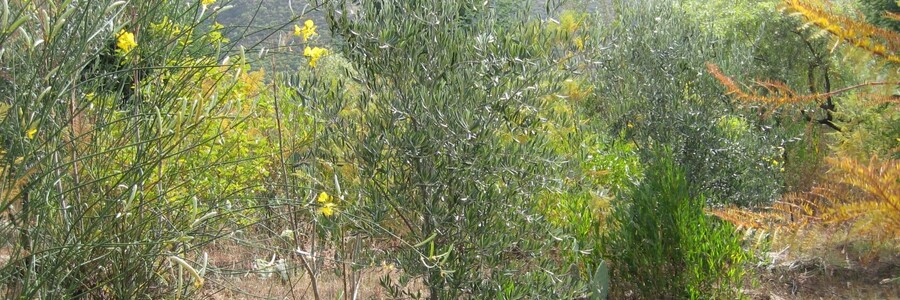From monoculture to diversity
The method of dynamic agroforestry (Spanish: Agroforesteria dínamica, or AD for short) is based on the knowledge of the indigenous peoples of Latin America and was promoted and further developed by the German Development Service (DED) in the 1990s.
The positive results with AD led to the foundation of the agroforestry research farm Mollesnejta in the highlands of Bolivia in 2001, with which we cooperate today. The aim of the research work is to find an optimal combination of plants under the given difficult site conditions with degraded, stony soils on slopes in a semi-arid climate at an altitude of 2,800 metres, which, with simple and practical maintenance work, lead to a variety of agricultural products.
Structure and handling of a plot
A dynamic agroforestry plot consists of agricultural crops, fruit trees and a variety of indigenous plants, especially native bushes and trees, so that the closed nutrient cycles of a natural forest are imitated.
The native bush and tree species take on a variety of functions. Deep-rooted plants suck water up from deeper soil layers and thus maintain soil moisture. Through regular pruning, especially of trees, the soil is always covered with a layer of leaves and mulch, protecting it from drying out.
Over time, the cuttings decompose and significantly increase the humus content. The increasing humus content and plant diversity, leading to a natural balance between pests and beneficial insects, promotes overall plant health. Some plants take on a "nurse function" for the crops grown, such as maize, potatoes, vegetables, berries and fruit trees, by providing shade, protection from wind, heavy rain and hail, and mulch and biomass. At the same time, they promote soil fertility and soil moisture through humus and nitrogen enrichment.
Periodic pruning is important
The management of such a natural forest plot consists mainly of periodic pruning of shrubs and trees, which keeps the system in a constant state of development, which decisively promotes the productivity of the cultivated crops.
The mulch layer, dense foliage and deep soil rooting counteract erosion, while preventing the leaching of nutrients and the drying out of the soil. This often means that neither fertilisers nor irrigation are necessary. Biodiversity in the plot eliminates the need for pesticides, allows for product diversification and thus produces an increased harvest.
Advantages of dynamic agroforestry
A scientific study conducted in 2011 by the Universidad Católica Boliviana "San Pablo" on soil quality in Mollesnejta showed that in plots with dynamic agroforestry, the humus content in the soil increases significantly in just a few years.
Another agroforestry study conducted on behalf of GIZ in 2013 shows that in the semi-arid zones of the department of Cochabamba, the crops of a plot with dynamic agroforestry have a higher drought tolerance, lower pest pressure and fewer plant diseases. At the same time, this has the effect that less to hardly any irrigation, fertiliser and plant protection products are needed.
Although the labour input in the first three years is higher than in conventional production systems, in the medium and long term the effort and costs are significantly reduced.
AGRECOL-Andes, the national park authority SERNAP (Servicio Nacional de Áreas Protegidas) and the agroforestry network ECO-SAF want to spread the dynamic agroforestry cultivation method in Tunari National Park. AGRECOL-Andes is aware of the needs of smallholder families in rural Bolivia and uses exclusively participatory methods that actively involve the target groups in the entire project implementation processes.
The principles of dynamic agroforestry are obvious. However, converting an arable plot to dynamic agroforestry usually means more work for the smallholder families in the beginning and a new approach to growing agricultural crops. Therefore, training and counselling of the smallholders are important throughout the project period.

